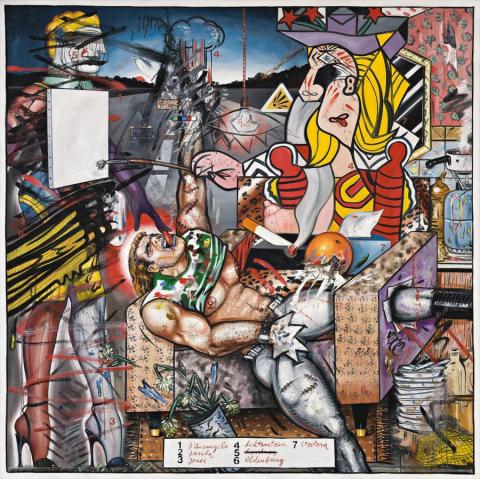THE STUDIO, 1984
JUAN DAVILA
oil on canvas
200.0 x 200.0 cm
signed, dated and titled verso: "THE STUDIO" / JUAN DAVILA 1984.
Kalli Rolfe Contemporary Art, Melbourne
Private collection, Melbourne
Juan Davila Retrospective, National Gallery of Victoria, Melbourne, 30 November 2006 – 4 February 2007
Juan Davila, Museum of Contemporary Art, Sydney, 25 September – 12 November 2006
Juan Davila: Paintings 1980/84, Galleria Su, Santiago, 1984
Davila, J. and Taylor, P., Juan Davila: Hysterical Tears, Greenhouse Publications, Melbourne, 1985 (illus. p. 95)
Brett, G., and Benjamin, R., Juan Davila, The Miegunyah Press, Melbourne, and Museum of Contemporary Art, Sydney, 2006, p. 103 (illus. pl. 28)
'We seem to have lost the capacity to relate to any other culture or being but the Western one'. Social issues, disturbance, difference, misery, madness and strangeness are silenced by emphasising in the other only that which resembles us, or by distancing the other and its desire as alien, thus erasing the capacity of anyone to address or challenge us.1
With his unswerving belief in the role of the artist as 'provocateur', for over four decades Chilean-born artist, Juan Davila has consistently interrogated prevailing cultural, social and sexual identities to create an art that is as uncomfortable at times as it is compelling. Whether critiquing the Australian political system, the greed of late capitalism, the oppression exerted by Western art history or the treatment of marginalised people in both Chile and Australia, his work is strident and confrontational, yet strangely seductive and always unforgettable - bestowing a lingering sense of disquiet and inevitably disturbing our world view.
Throughout his rich and varied oeuvre, one of Davila's signature techniques has been his 'cultural quotation style' which juxtaposes allusions and references to other artists alongside the visual landscape of the street (comic strips, tarot cards, pornography, political cartoons etc.). While this challenge to the 'high-low' divide is reminiscent of the Western avant-garde as espoused by Dada and Pop Art, importantly the strategy also evokes the hybrid modernism of his native Latin America which typically incorporates indigenous, colonial and external influences. Betraying contradictory qualities of refinement and tackiness, mimicry and invention, celebration and condemnation, The Studio, 1984 encapsulates well the fragmentary implications of this 'collage' approach, invariably employed by the artist to promote uncomfortable ambiguity and create subtle shifts in perception.
Situating himself here as the central figure, Davila offers a complex fusion of Pop Art 'quotations' -from the hallmark 'Ben Day Dots', yellow and red primary palette enclosed with thick black lines, and presence of the 'mushroom cloud' so characteristic of Roy Lichtenstein's comic-book strip paintings, to the female figure in stiletto heels which is clearly borrowed from the work of British Pop artist, Allen Jones. There are similarly echoes of Allan D'Arcangelo in the pictorial backdrop which draws the viewer's eye to the horizon along an American highway, and Swedish-American artist, Claes Oldenburg in the motif of the 'everyday object' couch. Notably, Davila also deliberately includes - yet simultaneously attempts to efface - the figure representation of Richard Lindner and emphatically strikes a line through his name in the index, suggesting his disdain for the German-American painter renowned for promoting gender roles in the media.
Blatantly acknowledging his sources here through the use of stencilled red numbers (itself a device pioneered by Lichtenstein) and an index of multiple authors, Davila thus pointedly challenges the Western concept of 'originality' as symbolised by the artist's signature - undermining the systems of authentication that confirm identity, ownership and value in capitalist culture. Moreover, the dismantling of pictorial unity that occurs through the collision of so-called 'high art' with mundane imagery (the tissue box, mirror and experiments bubbling over on a stovetop for example, all described as 'etcetera') serves not only to question the hierarchies applied to images, but to destabilise the power both historically accorded to the artist as the originator of art's fixed meanings and ultimately, the Western tradition as the dominant cultural narrative.
Highly respected for his resonant social voice, Davila has exhibited widely throughout Australia, South America, North America and Europe since the 1970s. His work was included in the 1982 and 1984 Biennales of Sydney and the 1998 Bienal de Sao Paulo, Brazil, and featured prominently in Documenta 12, Kassel, Germany, in 2007. In 2006, a major retrospective exhibition was held at the Museum of Contemporary Art, Sydney and National Gallery of Victoria, Melbourne, while other notable recent achievements include The Moral Meaning of Wilderness, Monash University Museum of Art, Melbourne, 2011 and the non-acquisitive Benalla Nude Art Prize which he was awarded in 2014. Today his work is held in all major public collections throughout Australia, as well as the Metropolitan Museum of Art, New York and Museo Extremeno e Iberoamericano de Arte Contemporaneo, Madrid.
1. Davila, J., 'A Brief Commentary by the Artist' in Juan Davila: Works 1988-2002, The Australian National University Drill Hall Gallery, Canberra, 26 September -3 November 2002, p. 13
VERONICA ANGELATOS
